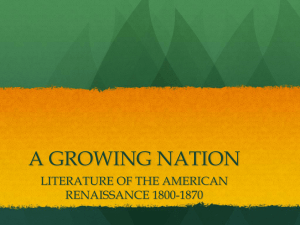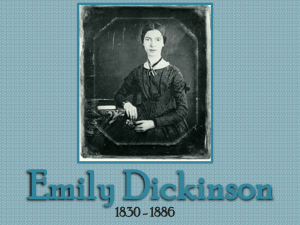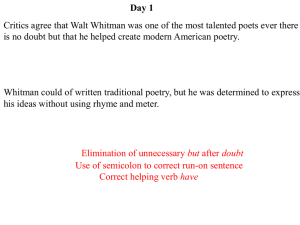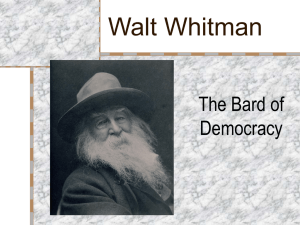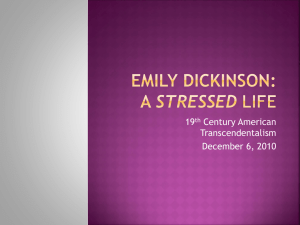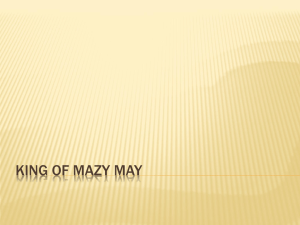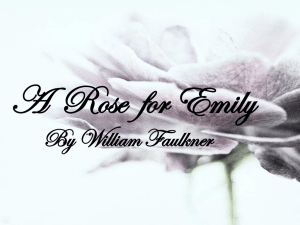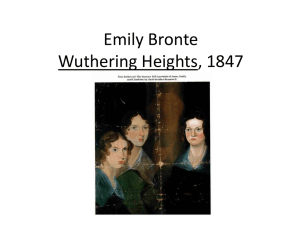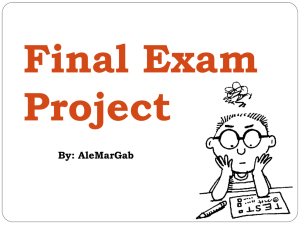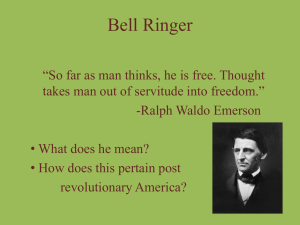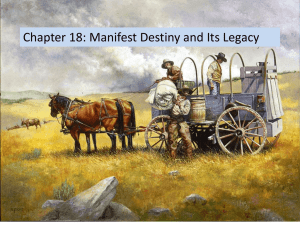Whitman & Dickinson PPT
advertisement
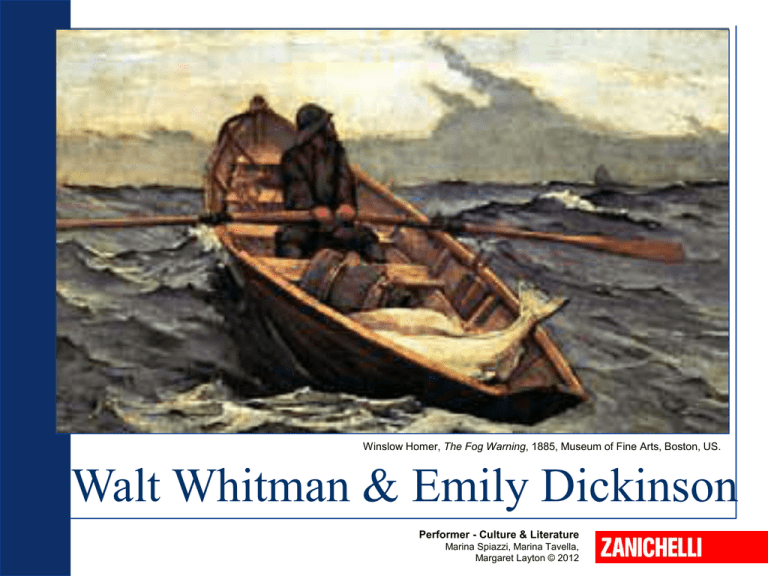
Winslow Homer, The Fog Warning, 1885, Museum of Fine Arts, Boston, US. Walt Whitman & Emily Dickinson Performer - Culture & Literature Marina Spiazzi, Marina Tavella, Margaret Layton © 2012 Walt Whitman & Emily Dickinson 1. Walt Whitman: life • He was born in New York into a working-class family in 1819. • He had little formal education. • At eleven he started to work as an office boy and then became a printer’s apprentice for a local newspaper. Walt Whitman • He became a journalist supporting radical democratic causes. Performer - Culture & Literature Walt Whitman & Emily Dickinson 1. Walt Whitman: life • He travelled widely through his country. • He acquired a self-taught culture including the Bible, Homer, Dante, Shakespeare, Carlyle, Goethe, Hegel, Emerson, oriental religion and philosophy. • • In 1855 he published the first edition of Leaves of Grass. Walt Whitman Nine editions followed, each containing new poems. Performer - Culture & Literature Walt Whitman & Emily Dickinson 1. Walt Whitman: life Performer - Culture & Literature • The third one, in 1860, aroused the indignation of puritanical readers and gained Whitman a reputation for obscenity and homosexuality. • During the Civil War he visited wounded soldiers in the army hospitals. • He continued to believe in the value of democracy and technological progress. Walt Whitman & Emily Dickinson 1. Walt Whitman: life Performer - Culture & Literature • The fourth edition of Leaves of Grass (1867) contained poems on the Civil War and on the death of President Lincoln. • In 1873 he retired to Camden, New Jersey, where he was visited by admirers and disciples. • He died in 1892. Walt Whitman & Emily Dickinson 2. Walt Whitman: his influence • Whitman’s popularity in Europe grew in the 1870s, especially appreciated by the Aesthetic Movement. • He influenced later poets such as Ezra Pound, Carl Sandburg, and, more recently, the Beat Generation. • He is generally regarded as the father of American poetry, as the first voice that was distinctly new and ‘American’. Performer - Culture & Literature Walt Whitman & Emily Dickinson 3. Leaves of Grass (1855) • Published on 4th July American Independence Day • Included a preface where the author introduced the subject matter, the language and the aim of his poetry. • Not a collection of poems but a life-long poem. Walt Whitman Performer - Culture & Literature Walt Whitman & Emily Dickinson 3. Leaves of Grass (1855) • A total of nine different editions published between 1855 and 1892. • Implied a process of development and expansion resulting from a transcendental sense of the unity of all things. • All of life and experience, reality itself, were a process, a continuing, all-embracing flow. Performer - Culture & Literature Walt Whitman & Emily Dickinson 4. Themes of Whitman’s poetry • Optimism and romantic faith in the dynamic future of the American nation. • Democracy and the ‘American dream’. • The self-celebration of the poet as a prophet of his country. • The dignity of the individual, conceived as the unity of body and soul. Performer - Culture & Literature Walt Whitman & Emily Dickinson 5. Song of Myself In Song of Myself Whitman divided his being into three. • Myself Whitman’s poetic personality • Me self Whitman’s inner personality • My soul An enigma, unexpected otherness Performer - Culture & Literature Walt Whitman & Emily Dickinson 5. Song of Myself Song of Myself celebrates the meeting between • The ‘I’ Whose reality is constantly questioned • The ‘you’ The ‘other’, ‘whoever you are’ Performer - Culture & Literature Walt Whitman & Emily Dickinson 6. Whitman’s style • Use of free verse. • Long lines where rhythm is determined by the thought or emotion expressed. • Use of accumulation and addition. • The participle often replaces the finite verb. • Use of dialect and common speech. • Few similes and metaphors. Performer - Culture & Literature Walt Whitman & Emily Dickinson 7. Emily Dickinson: life • She was born into a middleclass Puritan family in Amherst, Massachusetts, in 1830. • Her father, a lawyer and a politician, influenced her emotional development and religious belief. • She received her university education at Mount Holyoke Female Seminary. Performer - Culture & Literature Emily Dickinson Walt Whitman & Emily Dickinson 7. Emily Dickinson: life • She refused to declare her faith in public, as required by the Puritan tradition. • She interrupted her studies and returned home. • She began a life of seclusion and only wore white clothes as ambiguous emblems of spiritual marriage and singleness. • She never left her father’s house except for some walks in the garden. Performer - Culture & Literature Emily Dickinson Walt Whitman & Emily Dickinson 7. Emily Dickinson: life • She died in 1886. • Poems by Emily Dickinson appeared in 1890 published by the literary critic Thomas W. Higginson. • A complete edition of her poems appeared in 1955, edited by Thomas Johnson. • A collection of her letters was published in 1958. Performer - Culture & Literature Walt Whitman & Emily Dickinson 8. Influences on Dickinson • The Bible, Shakespeare, Milton, the Metaphysical poets. • Contemporary writers like Emily Brontë. • The Puritan tradition. • Emerson’s Transcendentalism. Performer - Culture & Literature The Homestead, East Facade Walt Whitman & Emily Dickinson 9. Dickinson vs. Whitman Emily Dickinson • The poet of what is broken and absent. • Detached from contemporary taste, from the great events and contrasts of the age. • Poetry of isolation. • Used her poetry to challenge received certainties. Performer - Culture & Literature Walt Whitman • The poet of wholeness. • Deeply interested and involved in the issues of his time. • Poetry of celebration. • His task was to respond to the spirit of his country, to give voice to the common man. Walt Whitman & Emily Dickinson 10. Themes in Dickinson’s poetry • • • • • • • Death and loss. Love and desire. Time. Fear, sorrow and despair. God. Nature. Man’s relation to the universe. Performer - Culture & Literature Walt Whitman & Emily Dickinson 11. The theme of death Death from the point of view of: •the person dying; •a witness. Death the great mystery, connected with eternity, a liberation from anxiety. Death the place where the human being tends to, in order to become one with the universe. Performer - Culture & Literature Walt Whitman & Emily Dickinson 12. The theme of love Love is explored through a full range of emotions: •from ecstatic and sensual celebration •to the despair due to separation. •Love expectation of eternity as the hope of a final spiritual union. Performer - Culture & Literature Walt Whitman & Emily Dickinson 13. The theme of nature Different from man: a source of wonder or fear. Can be presented: •through an objective description; •by juxtaposing the thing observed and the soul of the observer the natural datum leads to philosophical speculation; •as a source of imagery to emphasise an abstract concept or theme. Performer - Culture & Literature Walt Whitman & Emily Dickinson 14. Dickinson’s style • Poems do not have a title. • Short poems, organised in simple quatrains. • Use of monosyllabic words. • Terms from various sources: law, geometry, engineering. • Use of rhetorical devices such as imperfect rhymes, assonance, alliteration, paradox, metaphor, ellipsis and capitalisation. • Extensive use of dashes. Performer - Culture & Literature
